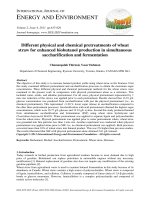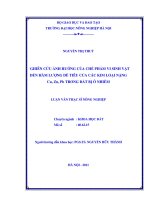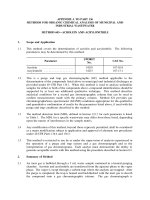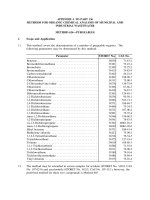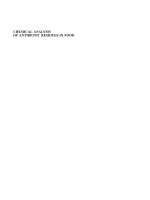Concentration and chemical speciations of cu, zn, pb and cr of urban soils in nanjing, china
Bạn đang xem bản rút gọn của tài liệu. Xem và tải ngay bản đầy đủ của tài liệu tại đây (108.71 KB, 11 trang )
Concentrations and chemical speciations of Cu, Zn,
Pb and Cr of urban soils in Nanjing, China
Ying Lu
a,b,
*
, Zitong Gong
a
, Ganlin Zhang
a
, Wolfgang Burghardt
c
a
Institute of Soil Science, Academia Sinica, Nanjing 210008, PR China
b
College of Resources and Environmental Science, South China Agricultural University,
Guangzhou 510642, PR China
c
Department of Applied Soil Science, University of Essen, 45141 Essen, Germany
Abstract
About 150 soil samples from 20 urban and 3 non-urban soil profiles in Nanjing were analyzed for
total concentrations of Cu, Zn, Pb and Cr using ICP spectrometry. The Cu, Zn, Pb and Cr of 23 urban
and non-urban topsoils (A horizon soils) were sequentially extracted into 5 fractions according to the
method of Tessier [Anal. Chem. 51 (1979) 844]. Total Cu, Zn, Pb and Cr concentrations of the urban
soils were 84.7 (48.1–139.7), 66.1 (12.2 – 869.4), 162.6 (57.7 – 851.6) and 107.3 (36.3– 472.6) mg
kg
À 1
, respectively. The soils were polluted with Cu, Zn and Cr to some extent and heavily polluted
with Pb. For 20 urban topsoils, the Cu, Zn, Pb and Cr were dominated by the residual fraction and
were least present in exchangeable fraction. On average, the order of Cr, Cu in each fraction was
residual (92.9%, 66.1%)Horganic (4.2%, 23.4%)>Fe–Mn oxide (2.7%, 5.4%)>carbonate (0.2%,
4.7%)>exchangeable (0.04%, 0.38%), Zn followed the order residual (60.0%)HFe – Mn oxides
(19.1%)>carbonate (11.6%)>organic (8.8%)>exchangeable (0.5%), Pb was residual (56.8%)>Fe –
Mn oxide (30.9%)Horganic (6.3%)>carbonate (5.2%)>exchangeable (0.8%). The percentage of
residual Cu and Zn decreased with the increase of total Cu and Zn concentrations. The proportion of
residual Pb increased with the increase of total P. The mobility and bioavailability of heavy metals
were Pb>Zn>Cu>Cr. Cu, Zn and Pb were more mobile and bioavailable in the urban than in the non-
urban soils; however, Cr was similar.
D 2003 Elsevier Science B.V. All rights reserved.
Keywords: Heavy metals; Chemical speciations; Urban soils; Nanjing, China
0016-7061/03/$ - see front matter D 2003 Elsevier Science B.V. All rights reserved.
doi:10.1016/S0016-7061(03)00079-X
* Corresponding author. College of Resources and Environmental Science, South China Agricultural
University, Guangzhou 510642, PR China. Tel.: +86-20-85280295.
E-mail address: (Y. Lu).
www.elsevier.com/locate/geoderma
Geoderma 115 (2003) 101–111
1. Introduction
Heavy metal contamination in urban soils can be harmful to the biota and human beings,
and extensive investigations have been carried out recently in some countries and regio ns
(Culbard et al., 1988; Thornton, 1991; Weiss et al., 1994; Chon et al., 1995; Markus and
McBrantney, 1996; Chen et al., 1997; Kasimov and Lychagin, 1998; Lavado et al., 1998;
Stroganova et al., 1998; Wilcke et al., 1998, 1999). Total analysis may give information
concerning possible enrichment of the soil with heavy metals, but it is generally recognized
that it is the chemical form of a metal in the soil that determines its mobilization capacity and
behavior in the environment. Sequential extraction provides information about the differ-
entiation of the relative bonding strength of metal on various solid phases and about their
potential reactivity under different physicochemical environmental conditions and is
considered useful for evaluating mobility and bioavailability of heavy metals in urban soils
(Harrison et al., 1981; Gibson and Farmer, 1986; Ramos et al., 1994; Tack and Verloo, 1995;
Wilcke et al., 1998, 1999). Of the various sequential extraction methods available, the one
followed most often is that proposed by Tessier et al. (1979).
China is the largest developing country with the largest population in the world. By the
end of 1999, China had 668 cities with 376 million urban inhabitants, which is 30.9% of
the total population, with an average density of 462 persons km
À 2
(State Statistical Bureau
and P.R. China, 2000). With continuing population growth and rapid economic develop-
ment of China, the percentage of population living in cities is increasing dramatically and,
consequently, the environmental quality of urban soils are becoming more and more
important in regards to human health. However, very little information is available about
heavy metals of urban soils in China (Lu, 2000). The objective of this study was to
determine the total Cu, Zn, Pb and Cr concentrations and chemical speciation of urban
soils in Nanjing, China.
2. Materials and methods
2.1. Description of study area
Nanjing city is located in eastern China (31j14VN, 118j22VE), and lies at the lower
reaches of the Yangtse River and north subtropical zone, with a history of more than 2000
years and about 3 million inhabitants. The average annual temperature of Nanjing city is
16.7 jC with a mean monthly variation ranging from 2.3 jC in January to 29.5 jC in July
and the mean annual precipitation is 1239 mm.
2.2. Soils
Twenty urban soil profiles, distributed in different districts including roadsides, urban
parks, residential areas, campuses and vegetable gardens within the urban area, and three
non-urban soil profiles nearby the urban area, were randomly selected. In all cases, the
soils were sampled according to pedogenetic horizons to a depth of about 1.2 m by digging
soil profiles. Altogether, 138 urban soil and 15 non-urban soil samples were collected. The
Y. Lu et al. / Geoderma 115 (2003) 101–111102
Table 1
Classification and some physicochemical properties of soils in this study
Profile
no.
Number of
horizons
Soil group
a
Locations Organic C
(g kg
À 1
)
CEC (cmol
(+) kg
À 1
)
pH
H
2
O
Sand
(g kg
À 1
)
Silt
(g kg
À 1
)
Clay
(g kg
À 1
)
Total P
2
O
5
(g kg
À 1
)
1 8 Tur-Anthric Entisols urban park 5.08 F 5.96
b
14.23 F 3.74 7.51 F 0.17 286.5 F 146.9 458.2 F 105.4 255.3 F 49.2 1.19 F 0.12
2 7 Tur-Anthric Entisols urban park 11.83 F 10.00 15.41 F 1.29 8.40 F 0.28 255.0 F 92.2 522.0 F 55.4 223.0 F 53.7 1.76 F 0.27
3 5 Arp-Udic Luvisols urban park 9.12 F 12.97 22.07 F 1.98 6.79 F 0.47 77.6 F 20.3 528.3 F 20.5 394.1 F 38.2 0.92 F 0.16
4 6 Hap-Orthic Gleysols campus 18.31 F16.86 16.43 F 2.15 8.26 F 0.21 342.4 F 31.2 478.8 F 39.4 178.8 F 38.9 3.06 F 0.65
5 8 Tur-Anthric Entisols campus 11.52 F 6.59 17.95 F 3.81 8.35 F 0.19 308.9 F 38.1 478.0 F 22.2 213.1 F 35.2 2.91 F 0.73
6 8 Tur-Anthric Entisols campus 10.01 F 4.03 16.09 F 4.57 8.45 F 0.25 245.7 F 118.9 559.8 F 43.4 194.6 F 78.5 5.20 F 2.21
7 9 Hyp-Udic Cambsols campus 21.35 F 14.90 16.40 F 1.82 8.43 F 0.21 289.9 F 127.3 575.0 F 80.3 135.1 F 53.1 6.67 F 1.63
8 8 Hyp-Udic Cambsols campus 12.11 F 4.73 16.54 F 1.21 8.40 F 0.23 216.1 F 33.6 615.1 F 35.4 168.9 F 15.1 7.74 F 2.77
9 6 Fim-Orthic Anthrosols vegetable
garden
11.00 F 4.34 16.98 F 1.12 6.93 F 0.96 246.3 F 32.4 550.4 F 9.6 203.3 F 37.0 3.45 F 0.64
10 8 Tur-Anthric Entisols residential
area
9.26 F 2.87 21.05 F 1.74 8.48 F 0.51 273.7 F 122.5 514.7 F 43.1 211.6 F 105.0 3.08 F 0.40
11 7 Tur-Anthric Entisols roadside 28.53 F 7.97 17.68 F 1.74 8.06 F 0.25 361.0 F 64.7 504.5 F 78.0 122.3 F 11.1 3.87 F 0.43
12 8 Tur-Anthric Entisols residential
area
13.44 F 4.10 18.71 F 1.93 8.16 F 0.27 241.4 F 43.5 514.5 F 38.3 244.2 F 59.6 2.42 F 0.81
13 6 Tur-Anthric Entisols residential
area
14.14 F 9.32 18.47 F 1.53 8.40 F 0.17 270.6 F 100.4 522.5 F 32.9 206.8 F 82.8 4.47 F 2.92
14 4 Tur-Anthric Entisols residential
area
36.16 F 10.18 13.63 F 3.51 8.22 F 0.07 505.4 F 189.5 402.1 F 132.1 92.6 F 60.2 4.50 F 0.66
15 7 Hyp-Udic Cambsols urban park 6.76 F 6.76 14.83 F 2.24 7.59 F 0.86 151.6 F 79.6 591.2 F 66.6 257.2 F 99.7 2.04 F 0.24
16 6 Hyp-Udic Cambsols urban park 5.83 F 7.37 11.98 F 3.78 7.44 F 0.43 376.2 F 164.3 504.0 F 110.5 119.8 F 61.3 2.53 F 0.53
17 7 Tur-Anthric Entisols roadside 19.54 F 13.48 13.73 F 2.91 8.16 F 0.28 403.6 F 151.6 468.6 F 113.3 127.8 F 59.8 3.45 F 1.77
18 7 Tur-Anthric Entisols roadside 13.35 F 13.71 18.12 F 2.21 7.99 F 0.17 211.3 F 110.1 549.8 F 72.2 238.9 F 67.7 3.96 F 1.41
19 7 Tur-Anthric Entisols campus 14.26 F 10.90 18.09 F 1.91 7.93 F 0.27 166.0 F 136.0 607.0 F 69.2 227.0 F 84.6 4.36 F 1.53
20 6 Fim-Orthic Anthrosols vegetable
garden
9.83 F 7.02 22.18 F 5.91 7.85 F 0.27 102.5 F 36.8 532.5 F 100.7 365.1 F 130.7 1.97 F 1.13
a 6 Arp-Udic Luvisols rural area 4.68 F 3.32 12.91 F 0.96 7.14 F 0.22 75.0 F 8.5 626.2 F 25.8 298.8 F 26.0 1.32 F 0.24
b 4 Fer-Udic Luvisols rural area 4.77 F 4.94 11.02 F 2.66 5.83 F 0.17 556.3 F 94.3 263.3 F 53.8 108.5 F 63.5 2.60 F 0.11
c 5 Fer-Udic Cambsols rural area 6.75 F 7.90 9.64 F 3.00 5.24 F 0.68 664.8 F 24.2 304.8 F 26.0 30.4 F 6.1 0.42 F 0.18
a
Soil classification was based on Chinese Soil Taxonomy (Gong, 1999).
b
Data in the table stand for mean F standard deviation of each soil profile.
Y. Lu et al. / Geoderma 115 (2003) 101–111 103
horizon numbers of each profile and soil classification are shown in Table 1. Soils were
air-dried and ground in an agate mortar to pass through a 2-mm nylon sieve. A subsample
(10 g) of each soil was furt her ground to pass throu gh a nylon sieve with 0.15-mm
openings.
2.3. Soil analyses
Soil pH was meas ured in a 1:2.5 (w/v) ratio of soil to water by a glass electrode.
Particle size analysis was made using the pipette method (Gee and Bauder, 1986). Organic
C was measured using Walkley– Black titration (Nelson and Sommers, 1982). Cation
exchangeable capacity (CEC) was determined as described by Chapman (1965). Total P
was determined with HClO
4
digestion (Olsen and Sommers, 1982). Some physicochem-
ical properties of soils used in the study are given in Table 1.
The sequential extraction scheme proposed by Tessier et al. (1979) was adopted to
partition the heavy metals into five fractions: exchangeable, bound to carbonates, bound to
Fe–Mn oxides, bound to organic mat ter and residual. Each fraction was defined as follows:
Exchangeable (F1): Soil (2.00 g dry wt.) extracted with 16 ml of pH 7, 1.0 mol l
À 1
MgCl
2
in 100-ml polyethylene centrifuge tubes for 1 h at room temperature with
continuous agitation.
Carbonate (F2): Residue from exchangeable fraction, extracted with 16 ml of pH 5 1.0
mol l
À 1
sodium acetate for 5 h at room temperature with continuous agitatio n.
Fe–Mn oxide (F3): Residue from carbonate fraction, extracted with 40 ml of 0.04 mol
l
À 1
NH
4
OHÁHCl in 25% acetic acid (v/v) for 5 h at 96 F 3 jC with occasional agitation.
Organic (F4): Residue from Fe–Mn oxide fraction, extracted with 6 ml of 0.02 mol l
À 1
HNO
3
and 10 ml of 30% H
2
O
2
adjusted to pH 2 with HNO
3
. The mixture was heated to
85 F 2 jC for 2 h with occasional agitation. A second 6-ml aliquot of 30% H
2
O
2
(pH 2
with HNO
3
) was then added and the sample was heated again to 85 F 2 jC for 3 h with
intermittent agitation. After cooling, 10 ml of 3.2 mol l
À 1
NH
4
OAc in 20% (v/v) HNO
3
was added and the sample diluted to 40 ml and agitated continuously for 30 min.
Residual (F5): Residue from the organic fraction was washed with deionized water,
dried in a force-air oven at 40 jC for 24 h, weighed and ground to pass a nylon sieve with
0.15-mm openings. A 0.2-g subsample was used for determining Cu, Zn, Pb and Cr
contents.
Total Cu, Zn, Pb and Cr contents in soils and residual fractions were determined by
attacking about 0.2000 g of dried soil samples with HNO
3
–HF–HClO
4
mixture followed
by elemental analysis. The Cu, Zn, Pb and Cr concentrations of all solutions were
determined by ICP (JY38S, Jobin Yvon, France).
3. Results and discussions
3.1. Heavy meta l concentrations
The concentrations of Cu, Zn, Pb and Cr in urban soils in Nanjing (Table 2) have a
wide range of values and have a marked vertical variability in soil profiles. The mean Cu
Y. Lu et al. / Geoderma 115 (2003) 101–111104
concentration is triple the mean value of soils in China and twice as much as the natural
background value of soils in the Nanjing area. The mean tota l Zn concentration is greater
than the mean value of soils in China and twice as much as the natural background value
of soils in the Nanjing area. The mean total Pb concentration is four times more than the
mean value of soils in China and the natural background value of soils in the Nanjing
area. The mean total Cr concentration is higher than the mean value of soils in China
and the natural background value of soils in the Nanjing area. Taking the natural
background values + 2 standard deviation as an evaluation criteria (Lu, 1999), 31.9%,
41.3% and 16.7% o f urban soils in Nanjing are polluted with Cu, Zn and Cr,
respectively. Pb concentration in urban soils are higher than pollution evaluation criteria
(57.4 mg kg
À 1
), with the exception of several urban park soils. The mean concentration
of Pb is the highest in the roadside soils and the lowest in the urban park soils; this
suggests that the emission from vehicles may be the main source of Pb contamination in
urban soils. The concentrations of Cu, Zn, Pb and Cr in non-urban soils are much lower
than those in urban soils, and are not polluted by Cu, Zn, Pb and Cr. Anthropogentic
source contributes to elevated levels of Cu, Zn, Pb and Cr concentrations in urban soils,
and that soil horizons were scraped, filled, mixed, etc. repeatedly can interpret vertical
variability of Cu, Zn, Pb and Cr concentrations in urban soil profiles. Similar findings
were reported by Culbard et al. (1988), Chon et al. (1995), Sa
´
n
ˇ
ka et al. (1995) and
Lavado et al. (1998).
There are positive correlations among Cu, Zn, Pb and Cr concentrations (Table 3).
Significant positive correlation between organic carbon and Cu, Zn, Pb and Cr concen-
trations suggests that those four metals have strong affinity with organic matter. Cu, Zn
and Pb concentrations are inversely correlated with clay content and directly correlated
Table 2
The Cu, Zn, Pb and Cr contents of urban soils in different zones and background values in Nanjing area and the
mean values in China (mg kg
À 1
)
Cu Zn Pb Cr
Urban park soils range 12.2 – 48.2 57.7–143.3 36.3 – 89.9 49.8 – 117.8
mean F S.D. 29.2 F 9.1 89.3 F 19.1 57.7 F 11.0 76.1 F14.8
Campus soils range 23.5 – 869.4 83.4 – 851.7 58.5 – 472.6 56.1–123.3
mean F S.D. 74.8 F 121.2 170.0 F 117.4 133.2 F 70.0 84.5 F 11.8
Residential area soil range 27.0 – 228.3 93.9 – 432.7 57.7 – 251.4 54.7–139.7
mean F S.D. 66.4 F 46.4 167.2 F 92.9 99.7 F 47.9 89.4 F 20.9
Roadside soil range 30.9–306.9 80.5 – 769.0 62.0–308.5 48.1 – 118.8
mean F S.D. 117.3 F 83.4 280.3 F 194.3 151.4 F 68.2 88.6 F 20.3
Vegetable garden soil range 30.8 – 54.6 86.9–185.4 74.3 – 101.7 63.7–118.3
mean F S.D. 43.0 F 7.9 120.1 F 32.6 83.62 F 9.44 92.0 F 16.6
All urban soils range 12.2 – 869.4 57.7 – 851.6 36.3 – 472.6 48.1–139.7
mean F S.D. 66.1 F 84.0 162.6 F 123.9 107.3 F 62.6 84.7 F 17.0
Non-urban soils range 18.30 –34.35 41.82 – 127.59 trace – 33.99 6.89 – 76.25
mean F S.D. 25.43 F 4.4 75.15 F 30.8 17.49 F 11.2 41.89 F 23.6
Background value in Nanjing area
a
(mean F S.D.) 32.2 F 13 78.6 F 29.5 24.8 F 16.3 59.0 F 20
Mean values in China
b
22.0 100.0 23.6 53.9
a
The Group of Natural Background Values of Soil and Academia Sinica (1979).
b
Liu (1996).
Y. Lu et al. / Geoderma 115 (2003) 101–111 105
with sand content. Cr concentrations have no significant correlation with the contents of
sand, silt and clay. The results are quite different from natural soils in which the Cu, Zn,
Pb and Cr concentrations increased with the increase of clay content (Xu and Yang, 1995;
Liu, 1996). Lu (2000) reported that Cu, Zn, Pb and Cr in Nanjing urban soils were
mainly o riginated from anthropogentic input, and soil organic C negatively correlated
with clay content, these probably result in different distribution of Cu, Zn, Pb and Cr in
particle size fractions of urban soils from natural soils, and the resul ts need be further
confirmed.
3.2. Heavy meta l fractions in topsoils (A horizon soils)
Recovery of the heavy metals during the sequential extraction procedure can be judged
by comparing the sum of each fraction wit h the total heavy metal concentrations.
Recovery is essentially quantitative within the precision of the method. Table 4 shows
satisfactory agreement between the total concentrations of heavy metals and the sum of the
individual fractions. There is a good correlation between the sums of the heavy metal
fractions and the total concentrations. The coefficients for Cu, Zn, Pb and Cr are 0.997,
0.989, 0.990 and 0.986 ( P < 0.01), respectively.
The Cu, Zn, Pb and Cr fractions expres sed as amounts and percentages of the sum
of individual chemical fractions are presented in Table 5. The distribution of metals
varies greatly among the samples. Only very small amounts of Cu, Zn, Pb and Cr are
present in the exchangeable fraction, most of which are present in the residual
fraction.
The highest percentage of Cu associated with the residual fraction averages 66.1% and
the lowest with exchangeable fraction averages 0.38%. An average 4.7%, 5.4% and
23.4% of Cu is associated with the carbonate, Fe–Mn oxide and organic form s, res-
pectively. The percentage of Cu fraction follows the order as residualHorganic>Fe–Mn
oxides>carbonate>exchangeable. In roadside soils, however, the highest amounts of Cu
Table 3
Correlation coefficients between Cu, Zn, Pb and Cr contents and urban soil properties (n = 138)
pH Organic C Sand Silt Clay Cu Zn Pb Cr
Cu 0.124 0.463** 0.339** À 0.165 À 0.346** 1.000
Zn 0.147 0.693** 0.455** À 0.247** À 0.447** 0.838** 1.000
Pb 0.281** 0.578** 0.330** À 0.011 À 0.471** 0.815** 0.814** 1.000
Cr 0.008 0.342** 0.119 À 0.084 À 0.106 0.400** 0.404** 0.355** 1.000
** Significant at the 0.01 probability level.
Table 4
Metal recovery from the sequential extraction analysis (all topsoils) (%)
Cu Zn Pb Cr
Range 84.4 – 117.0 81.1 – 118.9 84.6 – 118.9 87.1 – 108.9
Mean F S.D. 103.8 F 7.9 95.5 F 8.5 104.1 F 9.4 96.7 F 4.9
Y. Lu et al. / Geoderma 115 (2003) 101–111106
are associated with the organic fraction with an average of 48.74% and only 31.47% with
the residual form, and the proportion of carbonate forms are obviously higher than other
urban soils. The results are in line with other investigations (Harrison et al., 1981).
The percentage of urban soil Zn in exchangeable, carbonate, Fe –Mn oxide and organic
fractions averages 0.46%, 11.62%, 19.10% and 8.78%, respectively. Most of the total Zn,
with an average of 60.03%, is present in the residual fraction. The percentage of Zn
fractions follows the order residualHFe– Mn oxides>carbon ate>organic>exchangeable.
The Pb in urban soils is mainly associated with residual and Fe–Mn oxide fractions,
making up 56.75% and 30.93%, respectively. Exchangeable is the lowest, only accounting
for 0.79%. The percentage of organic and carbonate are 6.33% and 5.20%, respectively.
The proportion of Pb fractions follows the order residual>Fe–Mn oxideHorganic,
carbonate>exchangeable.
The highest contents of Cr are associated with the residual fractions and average
92.92%. Exchangeable, carbonate, Fe –Mn oxide and organic fractions average 0.037%,
0.20%, 2.69% and 4.16%, respectively. The amount of Cr in each fraction follows the
order residualHorganic>Fe–Mn oxide>carbonate>exchangeable.
In non-urban topsoils, the residual fraction of Cu, Zn, Pb and Cr account s for 93.03%,
90.33%, 82.48% and 89.9%, respectively. The percentages of Cu, Zn and Pb in the
residual fraction are much higher than those in urban topsoils. There is no difference in the
proportion of Cr in the residual fraction between urban and non-urban topsoils. It was
reported that anthropogenic inputs, such as atmospheric deposition, street dust, etc., were
the main source s of Cu, Zn, Pb and Cr in Nanjing urban soils (Lu, 2000). For atmospheric
Table 5
Cu, Zn, Pb and Cr fractions expressed as percentage of sum of fractions (%)
Exchangeable Carbonate Fe – Mn
Oxide
Organic Residual
Cu urban topsoils range 0.08 – 0.79 1.30 – 17.22 0.07 – 12.83 6.51 –50.43 20.81–86.96
mean F S.D. 0.38 F 0.17 4.73 F 3.63 5.39 F 3.65 23.38 F 13.22 66.11 F 17.25
non-urban
topsoils
range 1.62 – 1.79 0.42 – 1.15 n.d.
a
– 3.60 1.51–5.51 91.72–95.12
mean F S.D. 1.68 F 0.10 0.81 F 0.37 1.20 F 2.08 3.29 F 2.04 93.03 F 1.83
Zn urban topsoils range 0.22 – 0.86 5.72 – 23.46 9.65 – 29.15 4.88 –14.86 43.39–76.94
mean F S.D. 0.46 F 0.18 11.62 F 5.39 19.10 F 5.48 8.78 F 3.49 60.03 F 11.14
non-urban
topsoils
range 0.61 – 2.36 0.80 – 2.65 3.64 – 5.85 0.82–1.86 87.65 – 93.66
mean F S.D. 1.69 F 0.94 2.00 F 1.04 4.54 F 1.16 1.45 F 0.55 90.33 F 3.06
Pb urban topsoils range 0.43 – 1.27 2.95 – 9.69 20.37 – 42.67 2.71 –10.70 45.57–66.50
mean F S.D. 0.79 F 0.23 5.20 F 1.92 30.93 F 6.65 6.33 F 2.56 56.75 F 6.56
non-urban
topsoils
range 2.20 – 3.67 2.49 – 6.37 3.65 – 7.03 4.04–6.46 76.82 – 87.61
mean F S.D. 3.07 F 0.77 3.90 F 2.15 5.24 F 1.70 5.31 F 1.21 82.48 F 5.41
Cr urban topsoils range n.d. – 0.12 n.d.–1.68 n.d. – 6.72 2.61–6.70 88.70 – 95.40
mean F S.D. 0.04 F 0.03 0.20 F 0.41 2.69 F 1.46 4.16 F 1.19 92.92 F 1.85
non-urban
topsoils
range 1.60 – 4.31 0.11 – 0.34 2.15 – 4.81 4.34–5.64 87.56 – 91.60
mean F S.D. 2.52 F 1.55 0.20 F 0.12 3.07 F 1.51 4.81 F 0.72 89.40 F 2.04
a
Not dectected.
Y. Lu et al. / Geoderma 115 (2003) 101–111 107
deposition and street dust, the major portion of Cu, Zn and Pb were associated with Fe–
Mn oxide or organic fraction, with small percentage in residual fraction (Harrison et al.,
1981; Gao et al., 1995; Wang et al., 1998), which result in the different distribution of Cu,
Zn and Pb fractions between urban soils and non-urban soils. The results show a certain
similarity between the speciation patterns of Cr for urban and non-urban topsoils and
perhaps for the high residual fraction of anthropogenic input Cr such as atmospheric
deposition (Gao et al., 1995).
The exchangeable fraction was the first to be brought into solution and is
considered to be easily available for plan t uptake, th e carbonate fraction was
susceptible to pH changes, the Fe–Mn oxide fraction was unstable under low Eh
conditions, the organic fraction could be degraded under oxidizing conditions and the
residual fraction was not considered to create a bioavailable pool since it was not
expected to be solubilized over a reasonable period of time under natur al conditions
(Tessier et al.,1979). The amounts of non-residual fractions represent the amounts of
active heavy metals (Xu and Yang, 1995). The non-residual fractions of Cu, Zn, Pb
and Cr in urban soil s average 33.89%, 39.97%, 43.25% and 7.08%, respectively,
which suggests that the mobility and bioavailability of the four metals probably
declined in the following order: Pb, Zn, Cu and Cr. The non-residual fractions of Cu,
Zn, Pb and Cr in non-urban soils average 6.7%, 8.7%, 16.5% and 10.1%, respectively.
Therefore, Cu, Zn and Pb in urban soils have higher mobility and bioavailability than
Table 6
Correlation coefficients between percentage of metal fractions and urban topsoil properties (n = 20)
Metal Percentage
of fractions
Total
metal
pH Organic C CEC Total P Sand Silt Clay
Cu exchangeable 0.418 À 0.343 0.324 0.061 0.097 À 0.186 0.075 0.231
carbonate 0.903** 0.032 0.165 À 0.335 0.255 0.617** À 0.451* À 0.515*
Fe – Mn oxide 0.505* 0.018 À 0.465* À 0.395 0.326 0.347 À 0.084 À 0.501*
organic 0.641** À 0.109 0.664** À 0.187 0.360 0.645** À 0.523* À 0.474*
residual À 0.793** 0.077 À 0.449* 0.297 À 0.400 À 0.696** 0.513* 0.575**
Zn exchangeable À 0.189 À 0.502* À 0.193 À 0.248 0.174 À 0.295 0.579** À 0.206
carbonate 0.788** À 0.033 0.607** À 0.253 0.284 0.454* À 0.410 À 0.282
Fe – Mn oxide 0.643** À 0.107 0.486* À 0.108 0.518* 0.368 À 0.324 À 0.238
organic 0.205 À 0.195 0.571** 0.202 À 0.186 0.091 À 0.277 0.187
residual À 0.759** 0.138 À 0.708** 0.116 À 0.337 À 0.424 0.435 0.198
Pb exchangeable 0.279 À 0.134 0.373 À 0.160 À 0.251 À 0.006 0.110 À 0.126
carbonate 0.741** 0.355 0.430 À 0.429 0.063 0.711** À 0.533* À 0.576**
Fe – Mn oxide À 0.906** À 0.012 À 0.487* 0.149 À 0.758** À 0.391 0.211 0.420
organic 0.357 À 0.058 0.639** 0.134 À 0.045 0.222 À 0.244 À 0.082
residual 0.380 À 0.067 0.153 À 0.043 0.862** 0.084 0.052 À 0.211
Cr exchangeable 0.337 À 0.035 0.037 À 0.106 0.013 0.201 À 0.153 À 0.160
carbonate À 0.199 0.284 À 0.139 À 0.045 À 0.097 0.572** À 0.477* À 0.403
Fe – Mn oxide À 0.045 0.149 À 0.232 À 0.365 À 0.167 0.538* À 0.538* À 0.269
organic À 0.115 À 0.059 0.576** 0.401 0.179 À 0.241 0.090 0.308
residual 0.148 À 0.141 À 0.157 0.044 0.037 À 0.401 0.476* 0.107
* Significant at the 0.05 probability level.
** Significant at the 0.01 probability level.
Y. Lu et al. / Geoderma 115 (2003) 101–111108
in non-urban soils. The mobility and bioavailability of Cr is not significantly different
between urban and non-urban soils.
3.3. Correlations between Cu, Zn, Pb and Cr fractions and urban soil properties
The relationship between the percentage of Cu, Zn, Pb and Cr fractions and urban soil
properties was evaluated by simple correlation procedures (Table 6).
Total Cu concentration was negatively correlated with the percent age of the residual
fraction and positively correlated with the percentage of organic, Fe–Mn oxide and
carbonate fraction. Total Zn concentration was negatively correlated with the percentage
of the residual fraction and positively correlated with the percentage of Fe –Mn oxides
and carbonate fractions. Tot al Pb concentr ation was nega tively correlated with the
percentage of oxide Pb and positively correlated with the percentage of carbonate Pb.
The percentages of organic fractions of Cu, Zn, Pb and Cr were correlated with organic C
contents.
Total P content was positively correlated with the percentage of residual Pb and
negatively correlated with the percentage of Fe –Mn oxide Pb. P concentration in urban
soils was much high (Lu et al., 2001a,b) and phospha te could form highly insoluble
pyromorphite with Pb (Janet, 1996); therefore, the proportion of residual Pb increased with
soil P content. The formation of Fe and Mn phosphates, which reduced the absorption and
combination of Fe– Mn oxide with Pb, resulted in an inverse correlation of total P content
with the percentage of Fe–Mn oxide fraction.
4. Conclusions
The urban soils in Nanjing were polluted with Cu, Zn and Cr to some extent and
heavily polluted with Pb. The mean concentration of Pb is the highest in the roadside soils
and the lowest in the urban park soils. This suggests that the emission from vehicles may
be the main source of Pb contamination in urban soils.There was a positive correl ation
among Cu, Zn, Pb and Cr concentrations. Cu, Zn and Pb concentrations were inversely
correlated with clay content and directly correlated with sand content. Cr concentration
had no significant correlation with the contents of sand, silt and clay.
For urban topsoils, the distribution of metals varied greatly among the samples. The Cu,
Zn, Pb and Cr were predominately present in the residual fraction. The order of Cr, Cu in
each fraction was residualHorganic>Fe–Mn oxides>carbonate>exchangeable, the
amount of Zn in each fraction followed the order residualHFe –Mn oxides>carbona-
te>organic>exchangeable and Pb in each fraction was residual>Fe –Mn oxidesHorganic,
carbonate>exchangeable. The mobility and bioavailability of the four metals declined in
the following order: Pb, Zn, Cu and Cr. Cu, Zn and Pb were more mobile and bioavailable
in the urban than in the non-urban soils; however, Cr was similar. The percentage of
residual Cu and Zn was negatively correlated with total Cu and Zn concentrations. The
organic carbon was positively correlated with the percentage of organic Cu, Zn, Pb and Cr
fraction. The total P content was directly correlated with the percentage of residual Pb and
inversely correlated with the percentage of Fe –Mn oxide Pb.
Y. Lu et al. / Geoderma 115 (2003) 101–111 109
Acknowledgements
This work was supported by the National Natural Science Foundation of China (grant
no. 40235054).
References
Chapman, H.D., 1965. Cation exchangeable capacity. In: Black, C.A. (Ed.), Methods of Soil Analysis.
Agronomy, vol. 9. Am. Soc. Agron., Madison, WI, pp. 891 – 901.
Chen, T.B., Wong, J.W.C., Zhou, H.Y., Wong, M.H., 1997. Assessment of trace metal distribution and contam-
ination in surface soils of Hong Kong. Environ. Pollut. 96, 61 – 68.
Chon, H.T., Kim, K.W., Kim, J.Y., 1995. Metal contamination of soils in Seoul metropolitan city, Korea. Environ.
Geochem. Health 17, 139 – 146.
Culbard, E.B., Thornton, T., Watt, J., Wheatley, M., Moorcroft, S., Thompson, M., 1988. Metal contamination in
British urban dusts and soils. J. Environ. Qual. 17, 226 – 234.
Gao, L.C., Feng, S.P., He, G.H., 1995. Specification of Cu, Zn, Pb in dust of different diameters. Res. Environ.
Sci. 8 (4), 35 – 39 (in Chinese, with English Abstr.).
Gee, G.W., Bauder, J.W., 1986. Particle size analysis. In: Klute, A. (Ed.), Methods of Soil Analysis: Part 1.
Physical and Mineralogical Methods. Am. Soc. Agron., Madison, WI, pp. 383 – 411.
Gibson, M.J., Farmer, J.G., 1986. Multistep sequential chemical extraction of heavy metals from urban soils.
Environ. Pollut. 11, 117–135 (series B).
Gong, Z.T., 1999. Chinese Soil Taxonomy. Science Press, Beijing, China (in Chinese).
Harrison, R.M., Laxen, D.P.H., Wilson, S.J., 1981. Chemical association of lead, cadmium, copper, and zinc in
street dusts and roadside soils. Environ. Sci. Technol. 15, 1378 – 1383.
Janet, C.H., 1996. Lead phosphate formation in soils. Environ. Pollut. 93, 9 –16.
Kasimov, N., Lychagin, M., 1998. Heavy metals in urban soils in Russia. Symposium 28: Urban and Suburban
Soils, Proc. World Cong. Soil Sci., Montpellier, France.
Lavado, R.S., Rodrı
´
guez, M.B., Scheiner, J.D., Taboada, M.A., Rubio, G., Alvarez, R., Alconada, M., Zubillaga,
M.S., 1998. Heavy metals in soils of Argentina: comparison between urban and agricultural soils. Commun.
Soil Sci. Plant Anal. 29, 1913 – 1917.
Liu, Z., 1996. Microelements in Soils of China. Jiangsu Sci. and Technol. Publishing House, Nanjing, China (in
Chinese).
Lu, Y.S., 1999. Environmental Evaluation. Tongji Univ. Press, Shanghai, China (in Chinese).
Lu, Y., 2000. The Characteristics and environmental significance of urban soils: a case study for Nanjing city.
PhD Thesis. Institute of Soil Science, Academia Sinica, Nanjing, China (in Chinese, with English Abstr.).
Lu, Y., Gong, Z.T., Zhang, G.L., 2001a. Features and classification of urban soils in Nanjing. Soils 33, 47–51
(in Chinese).
Lu, Y., Gong, Z.T., Zhang, G.L., 2001b. Phosphorus characteristics of urban soil and its relationship with P
concentration in groundwater. Chin. J. Appl. Ecol. 12, 735 – 738 (in Chinese with English Abstr.).
Markus, J.A., McBrantney, A.B., 1996. An urban soil study: heavy metals in Glebe, Australia. Aust. J. Soil Res.
34, 453 – 465.
Nelson, D.W., Sommers, L.E., 1982. Total Carbon, organic carbon, and organic matter. In: Page, A.L., Miller,
R.H., Keeney, D.R. (Eds.), Methods of Soil Analysis, Part 2, 2nd ed. Chemical and Microbiological Proper-
ties. Am. Soc. Agron, Madison, WI, pp. 539 – 579.
Olsen, S.R., Sommers, L.E., 1982. Phosphorus. In: Page, A.L., Miller, R.H., Keeney, D.R. (Eds.), Methods of
Soil Analysis, Part 2, 2nd ed. Chemical and Microbiological Properties. Am. Soc. Agron., Madison, WI,
pp. 403 – 407.
Ramos, L., Hernandez, L.M., Gonzalez, M.J., 1994. Sequential fractionation of copper, lead, cadmium and zinc
in soils from or near Don
˜
ana National Park. J. Environ. Qual. 23, 50 – 57.
Sa
´
n
ˇ
ka, M., Strnad, M., Vondra, J., Paterson, E., 1995. Sources of soil and plant contamination in an urban
environment and possible assessment methods. Int. J. Environ. Anal. Chem. 59, 327 – 343.
Y. Lu et al. / Geoderma 115 (2003) 101–111110
State Statistical Bureau, P.R. China, 2000. China Statistical Yearbook. China Statistical Publishing House, Bei-
jing, China (in Chinese).
Stroganova, M.N., Myagkova, A.D., Prikofieva, T.V., Skvortsova, I.N., 1998. Soils of Moscow and Urban
Environment. Moscow.
Tack, F.M.G., Verloo, M.G., 1995. Chemical speciation and fractionation in soil and sediment heavy metal
analysis: a review. Int. J. Environ. Anal. Chem. 59, 225 – 238.
Tessier, A., Campbell, P.G.C., Blsson, M., 1979. Sequential extraction procedure for the speciation of particulate
trace metals. Anal. Chem. 51, 844 – 851.
The Group of Natural Background Values of Soil, Academia Sinica, 1979. The natural background values of
some trace elements in the important soil types of Beijing and Nanjing areas. Acta Pedol. Sin. 16, 319 – 328
(in Chinese, with English Abstr.).
Thornton, I., 1991. Metal contamination of soils in urban areas. In: Bullock, P., Gregory, P. (Eds.), Soils in the
Urban Environment. Blackwell, Oxford, pp. 47 – 75.
Wang, W.H., Wong, M.H., Leharne, S., Fisher, B., 1998. Fractionation and biotoxicity of heavy metals in urban
dusts collected from Hong Kong and London. Environ. Geochem. Health 20, 185 – 198.
Weiss, P., Riss, A., Gschmeidler, E., Schentz, H., 1994. Investigation of heavy metal, PAH, PCB patterns and
PCCD/F profiles of soil samples from an industrialized urban area (Linz, Upper Austria) with multivariate
statistical methods. Chemosphere 29, 2223 – 2236.
Wilcke, W., Mu
¨
ller, S., Kanchanakool, N., Zech, W., 1998. Urban soil contamination in Bangkok: heavy metal
and aluminium partitioning in topsoils. Geoderma 86, 211–228.
Wilcke, W., Lilienfein, J., Lima, S.D.C., Zech, W., 1999. Contamination of highly weathered urban soils in
Uberla
ˇ
ndia, Brazil. J. Plant Nutr. Soil. Sci. 162, 539 – 548.
Xu, J.L., Yang, J.R., 1995. Heavy Metals in Terrestrial Ecosystem. China Environ. Sci. Press, Beijing, China (in
Chinese).
Y. Lu et al. / Geoderma 115 (2003) 101–111 111



